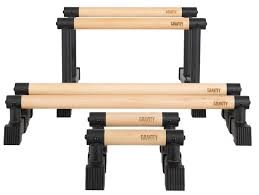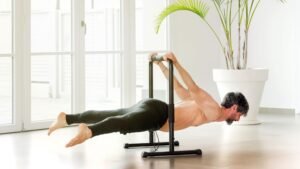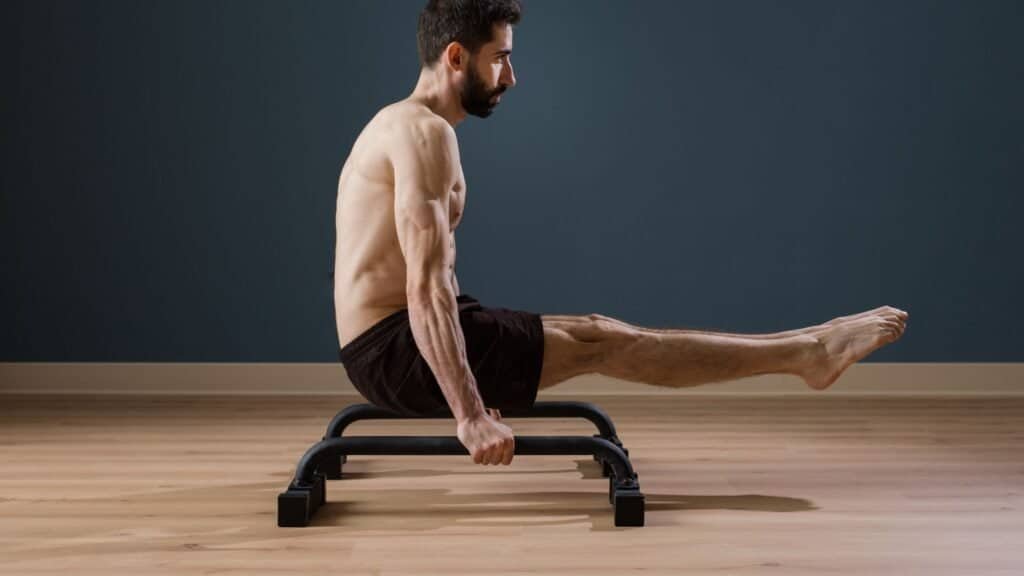
Table of Contents
Calisthenics home gym guide transforms your home into a fitness haven. This calisthenics guide leads you from rookie to pro, making every inch of your home a stage for growth, mastery, and resilience. Unveil the secrets of sculpting strength, enhancing flexibility, and achieving peak fitness with just your body weight. Whether you’re a calisthenics veteran or newcomer, this guide will break barriers, creating a home gym that surpasses your goals. Let’s transform your living space into a powerful arena where body weight exercises become an art form, and fitness becomes a way of life.
Benefits of Calisthenics Home Gym
Benefits of Calisthenics, a body weight exercise regimen, proves to be a holistic approach to fitness with advantages encompassing strength, flexibility, and overall physical and mental well-being of the enthusiasts.
1. Strength Enhancement :
it builds foundational strength by leveraging your body weight, targeting major muscle groups. The transformative power of exercises like push-ups, pull-ups, and squats in sculpting a robust physique is undeniable.
2. Flexibility:
Calisthenics exercise ensures dynamic movements that enhance joint mobility and contributes to improved flexibility, allowing a broader range of motion for day-to-day activities.
3. Cardiovascular Health:
Cardiovascular benefits of calisthenics as body weight exercises elevate heart rate, fostering cardiovascular health is a long known secret among health practitioners. There is an unbreakable synergy between strength training and cardio
4. Mental Well-being :
it also ensures stress reduction and mood enhancement. The mind-body connection inherent in these exercises contributes to a positive mindset.
5. Accessibility and Cost-Effectiveness:
It requires minimal or no equipment. This makes it seamlessly integrated into daily life, overcoming barriers associated with traditional gym settings.
Creating the Optimal Calisthenics Home Gym Environment
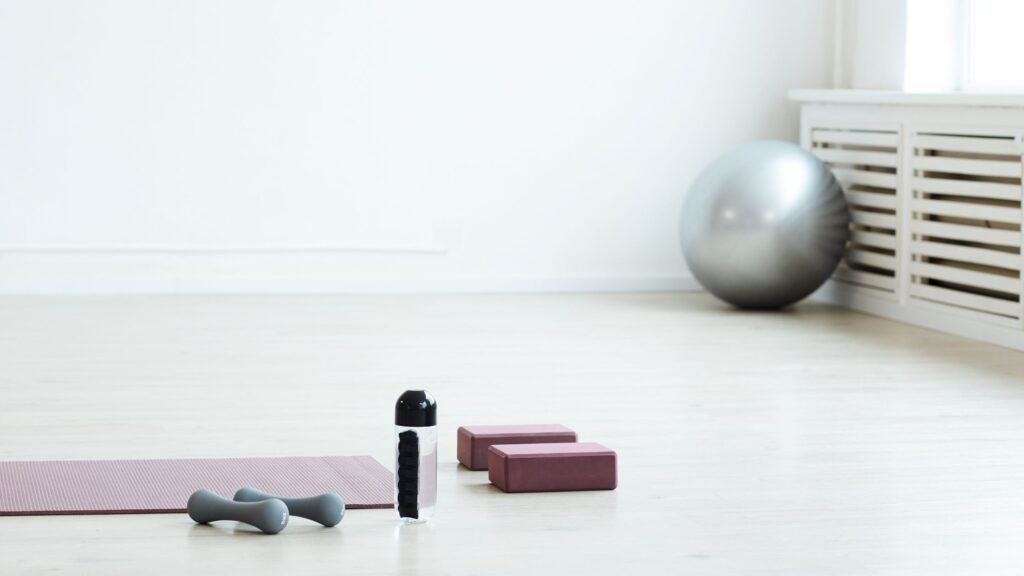
The journey of creating an optimal workout area designed for achieving success in calisthenics not only supports physical exercise but also serves as a catalyst for calisthenic triumph. The exploration encompasses the meticulous consideration of layout, equipment selection, and ambiance to ensure a space that not only accommodates the physical demands of calisthenics but also inspires a mental state conducive to sustained dedication and optimal performance.
1. Assessing Space:
Recognizing the significance of assessing the available space for calisthenics is paramount. It is a critical aspect that can profoundly impact the effectiveness of your workout routine. Analysis of room dimensions entails understanding how the layout of the space influences the flow and execution of calisthenics exercises. A strategic layout will enhance the overall experience, ensuring a seamless transition between different movements.
Moreover, taking into account potential obstacles is essential for creating a conducive environment for calisthenics success. Identifying and mitigating potential hindrances contribute substantially to the optimization of the workout area. This includes ensuring there are no physical barriers that could impede the fluidity of movements or compromise safety.
2. Location Selection:
Choosing the optimal location for your calisthenics space is a crucial decision that significantly influences the effectiveness and overall enjoyment of your workout routine. The careful consideration of various factors can transform a mere exercise area into a dynamic and inspiring environment.
• Natural Light:
Selecting a location with ample natural light is essential. Exposure to natural light like sunlight helps regulate circadian rhythms, enhancing energy levels and mood. A well-lit space ensures better visibility, reducing the risk of injuries and creating a more vibrant and inviting workout environment.
• Ventilation:
Adequate ventilation is essential to maintaining a comfortable and healthy workout space. Proper air circulation helps regulate temperature, preventing overheating during intense calisthenics sessions. It also ensures the removal of stale air and promotes the flow of fresh oxygen, contributing to better respiratory health and overall well-being.
• Proximity to Necessary Facilities:
Consider the convenience of the location in relation to necessary facilities. Easy access to amenities such as water sources, changing rooms, or restrooms enhances the overall convenience of your calisthenics space. This eliminates disruptions, allowing you to focus entirely on your workout without unnecessary interruptions.
3. Inspiring Atmosphere:
Cultivating an inspiring workout atmosphere is a key element in maximizing the benefits of calisthenics. This goes beyond the physical exercises and taps into the psychological and emotional aspects of fitness.
• Motivational Elements:
Infuse the space with motivational elements that resonate with you. It could be uplifting quotes, imagery of fitness achievements, or symbols of personal milestones. These are constant reminders of your goals, creating a positive mental environment that fuels determination and commitment throughout each calisthenics session.
• Personal Touches:
Tailor the workout area to reflect your personality and preferences like favorite colors, equipment with sentimental value, or a dedicated corner for personal achievements. This customization fosters a sense of ownership and connection to the space, making it a more enjoyable and meaningful setting for your calisthenics practice.
• Organized Equipment Layout:
The organization of equipment plays a pivotal role in maintaining a focused and efficient workout atmosphere. A well-organized layout ensures easy access to necessary tools, minimizes distractions, and streamlines transitions between exercises.
4. Utilizing Creative Storage Solutions:
Utilizing creative storage solutions is paramount when planning a calisthenics space, contributing significantly to an organized, clutter-free, and functional workout environment. Here’s why it matters and some creative ideas to achieve this:
I. Maximizing Space Efficiency:
Efficient storage solutions optimize the use of available space, making the calisthenics area more spacious and user-friendly.
Creative Ideas:
• Install wall-mounted shelves or pegboards to store smaller equipment like resistance bands, chalk, and gloves.
• Utilize vertical space with tall, slim storage units to store larger items without occupying valuable workout floor space.
II. Quick and Easy Access:
Easy access to equipment enhances the flow of the workout, reducing interruptions and ensuring a seamless exercise routine.
Creative Ideas:
• Use labeled storage bins or baskets for categorizing and quickly locating items like yoga mats, foam rollers, and smaller accessories.
• Incorporate pull-out drawers or sliding racks for convenient access to weights and other frequently used gear.
III. Visual Appeal and Motivation:
A visually appealing storage system
Creative Ideas:
• Display equipment on open shelving units, turning them into a part of the decor.
• Use vibrant storage containers or implement a color-coded system for a visually stimulating and organized
look.
IV. Multipurpose Furniture:
Furniture with built-in storage serves a dual purpose, providing functionality while minimizing clutter.
Creative Ideas:
• Opt for workout benches or ottomans with hidden storage compartments for storing smaller items like resistance bands and dumbbells.
• Incorporate a stylish storage bench for a seamless blend of utility and aesthetics.
V. Adaptability and Flexibility:
Storage solutions should be adaptable to evolving needs and flexible for accommodating a variety of equipment.
Creative Ideas:
• Invest in modular storage units that can be rearranged to accommodate new equipment or changing preferences.
• Consider mobile storage carts for flexibility, allowing easy relocation of equipment as needed.
Essential Calisthenics Home Gym Equipment
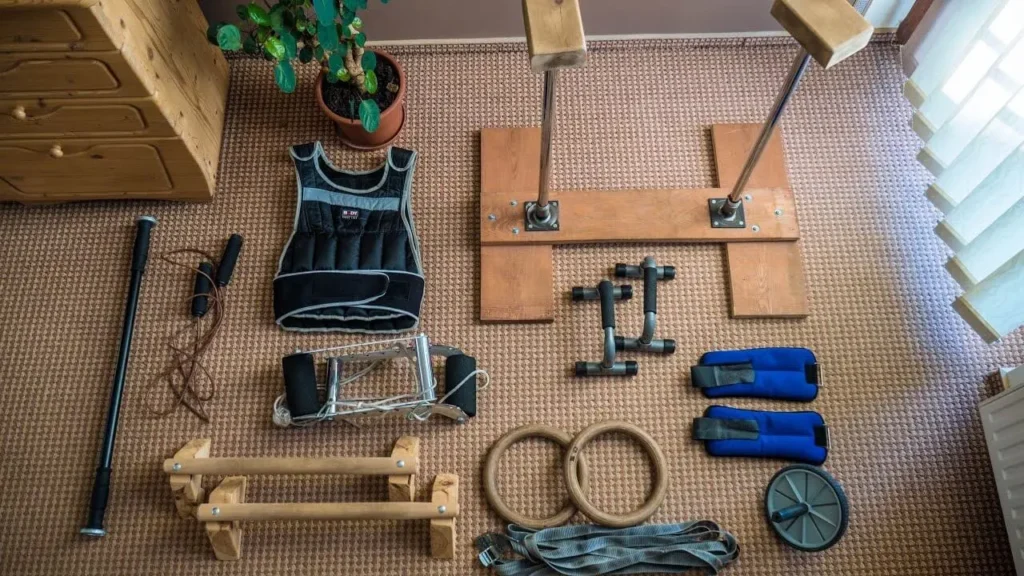
Welcome into the world of calisthenics with essential equipment that transforms your home into a dynamic fitness space. Explore the versatility of pull-up bars, gymnastic rings, and parallettes for a comprehensive workout experience.
1. Pull-Up Bars
Enhance your home gym with a robust pull-up bars, bringing a lot of benefits to your calisthenics quest. Benefits of Pull-Up Exercises:
• Upper Body Strength: Engage various muscle groups in the back, shoulders, and arms, fostering comprehensive upper body strength.
• Versatility: Explore a range of pull-up techniques, including wide grip, narrow grip, and chin-ups, to target different muscle fibers and achieve a well-rounded workout.
• Core Activation: Stabilize your body during pull-ups, activating core muscles and contributing to overall core strength.
Variety of Pull-Up Techniques:
• Wide Grip: broadens the back and improving overall width.
• Narrow Grip: Targets the inner back muscles, enhancing definition and providing a challenging variation.
• Chin-Ups: Focuses on the biceps and lower traps, promoting arm strength and upper back development.
Progression Tips:
Mastering pull-ups is a journey that accommodates all fitness levels. Progress systematically:
• Assisted Variations: Begin with assisted pull-ups or use resistance bands to build foundational strength.
• Gradual Intensity Increase: Progress from basic pull-ups to advanced variations as strength improves.
• Consistent Practice: Incorporate pull-ups into your routine consistently for steady improvement.
2. Gymnastic Rings
Uncover the unique benefits that gymnastic rings bring to your calisthenics routine:
• Enhanced Stability: Engage stabilizing muscles as you navigate exercises on the dynamic surface of gymnastic rings, promoting overall stability.
• Increased Range of Motion: Experience a fuller range of motion, fostering joint flexibility and functional movement patterns.
• Improved Core Strength: Challenge your core muscles during ring exercises, contributing to improved core strength and balance.
Variety of exercise ideas for Gymnastic Rings.
• Ring Dips: Targeting chest, triceps, and shoulders, ring dips provide a challenging variation compared to traditional parallel bars.
• Muscle-Ups: Elevate your upper body strength by mastering the transition from a pull-up to a dip on the gymnastic rings.
• Inverted Rows: Engage your back muscles with inverted rows, promoting a well-rounded upper body workout.
Progression Tips for Gymnastics Ring Training:
Gymnastics ring training is a challenging yet rewarding form of calisthenics. To progress effectively, consider the following tips:
• Master the Basics: Begin with foundational exercises like ring rows to build strength and control before advancing to more complex movements.
• Strengthen the Support Hold: Develop stability by practicing the ring support hold. Start with short holds and gradually increase duration as you build strength.
• Assisted Ring Dips: Use assistance, such as a resistance band, to perform ring dips with proper form. Gradually reduce assistance as your strength improves.
3. Parallettes
Parallettes serve as a versatile tool for elevating your calisthenics routine, offering benefits such as enhanced range of motion, muscle isolation, and exercise versatility. Master advanced movements like L-sits and handstands, prioritizing proper installation, stability, and precise hand positioning for a safe and effective workout.
I. The advantages that parallettes bring to your calisthenics practice:
• Enhanced Range of Motion: Amplify your exercise range, allowing for deeper and more effective movements compared to traditional floor exercises.
• Isolation of Muscle Groups: Target specific muscle groups with precision, fostering muscle engagement and development.
• Versatility in Exercises: From dips to push-ups, explore a multitude of exercises that challenge various aspects of strength and flexibility.
II. Unveil the techniques required for mastering advanced calisthenics movements using parallettes:
• L-Sits: Develop core strength and control by mastering the L-sit position on parallettes.
• Handstands: Progress to handstand exercises, refining your balance and shoulder stability.
III. Installation and Adjustment: Ensure a safe and effective workout by learning the proper installation and adjustment of parallettes:
• Stability: Understand the importance of a stable foundation for parallettes, preventing accidents during dynamic exercises.
• Hand Positioning: Master the optimal hand positioning for different exercises, ensuring precision and reducing the risk of strain or injury.
5. Crafting a Personalized Workout Plan:https://betterme.world/articles/30-day-calisthenics-workout-plan/
Focus on the following key aspects to strike a balance between strength, flexibility, and skill development for comprehensive fitness.
• Strength Training:
Incorporate exercises that target different muscle groups, emphasizing bodyweight movements such as push-ups, pull-ups, and squats.
• Flexibility Exercises:
Integrate dynamic and static stretches to enhance flexibility. Emphasize stretches that complement calisthenics movements, promoting increased range of motion and preventing injuries.
• Skill Development:
Include skill-specific exercises like handstands, planches, and muscle-ups to enhance coordination and proficiency in advanced calisthenics movements.
• Periodization:
Alternating between phases of high intensity and lower intensity helps prevent plateaus, allowing for continuous improvement in strength, flexibility, and skill acquisition.
• Recovery and Rest:
Prioritize recovery with adequate rest days, sleep, and proper nutrition. Recovery is crucial for muscle repair, flexibility maintenance, and overall workout performance.
• Progress Tracking:
Regularly assess and track your progress. Adjust the intensity and volume of exercises based on your evolving fitness levels and goals.
By focusing on these components, your personalized calisthenics routine will encompass a holistic approach, ensuring a comprehensive blend of strength, flexibility, and skill development for optimal fitness.
A. Beginner’s Challenges
Lay the foundation for a successful workout routine by incorporating fundamental exercises and implementing a gradual progression plan for optimal results.
1. Fundamental Exercises:
Begin with fundamental bodyweight exercises, including push-ups, squats, and lunges. These exercises build strength, enhance flexibility, and establish a solid fitness base.
2. Gradual Progression Plan:
Implement a structured progression plan that gradually increases the intensity and complexity of exercises. This approach prevents burnout, reduces the risk of injury, and ensures consistent improvement over time.
3. Consistency and Patience:
Emphasize the importance of consistency and patience. Building fitness is a gradual process, and maintaining a regular workout routine is key to long-term success.
B. Intermediate Challenges
Level Up Your Skills: Transition to intermediate challenges by incorporating more advanced movements and techniques into your fitness routine. Overcome plateaus and stay motivated with these tips.
1. Advanced Movements:
Integrate advanced bodyweight movements such as handstands, pistol squats, and muscle-ups. These exercises challenge your strength, balance, and coordination.
2. Overcoming Plateaus:
Implement progressive overload strategies to overcome training plateaus. Increase resistance, vary workout intensity, and introduce new exercises to stimulate muscle growth and prevent stagnation.
3. Staying Motivated:
Maintain motivation by setting specific goals, tracking progress, and diversifying your workout routine. Engage in activities you enjoy and consider seeking guidance from fitness communities or professionals.
C. Advanced Mastery
Pushing the Boundaries:
Embark on a journey of Advanced Mastery in calisthenics, pushing the boundaries to unlock impressive feats and achieve peak physical performance.
1. Progressive Calisthenics:
Engage in progressive calisthenics routines that challenge and surpass your current capabilities. Progressively increase difficulty to stimulate continuous improvement.
2. Calisthenics Feats:
Explore and conquer advanced calisthenics feats, including planches, one-arm pull-ups, and human flags. These feats showcase strength, balance, and body control.
3. Peak Physical Performance:
Attain peak physical performance by optimizing training intensity, recovery, and nutrition. Focus on well-rounded fitness, encompassing strength, flexibility, and endurance.
4. Functional Strength:
Emphasize functional strength development, ensuring that your body is not only aesthetically fit but also capable of performing real-world movements efficiently.
5. Skill Acquisition:
Master intricate calisthenics skills such as handstands, muscle-ups, and front levers. Skill acquisition enhances overall body awareness and control.
6. Training Periodization:
Incorporate training periodization to vary intensity and volume, preventing plateaus and optimizing long-term progress in advanced calisthenics.
7. Calisthenics Mastery Programs:
Explore specialized calisthenics mastery programs designed by experienced athletes and trainers. These programs offer structured guidance for achieving advanced mastery.
Creating a Consistent Routine for Calisthenics Home Gym
Discover the essential tips and strategies for establishing a sustainable calisthenics routine at home.
1. Daily Commitment:
Cultivate a daily commitment to your calisthenics routine. Consistency builds habits and accelerates progress.
2. Progressive Overload:
Implement progressive overload gradually, challenging your body with incremental increases in intensity for continuous improvement.
3. Variety in Workouts:
Keep your routine engaging by introducing variety. Explore different exercises and techniques to target various muscle groups.
4. Mindful Recovery:
Prioritize recovery days and listen to your body. Consistent rest is crucial for preventing burnout and ensuring long-term sustainability.
5. Structured Schedule:
Create a structured workout schedule that aligns with your daily routine. Consistency thrives in a well-organized plan.
6. Goal Setting:
Set achievable goals and milestones. Consistently working towards targets provides motivation and a sense of accomplishment.
7. Tracking Progress:
Use a workout journal or app to track your progress. Consistent monitoring allows you to make informed adjustments to your routine.
8. Social Support:
Build a supportive community. Whether online or offline, sharing your calisthenics journey with others enhances consistency.
9. Adaptability:
Embrace adaptability in your routine. Consistently modify your workout plan based on your evolving fitness levels and goals.
10. Enjoyment Factor:
Choose exercises you enjoy. Consistency flourishes when you find joy in your calisthenics routine.
In Conclusion, this comprehensive guide takes you on a journey from beginner to advanced levels in calisthenics home gym. It covers the benefits of calisthenics, creating an optimal workout environment, essential equipment, crafting personalized workout plans, and guides for beginners, intermediates, and advanced practitioners. The article emphasizes consistency, motivation, and mastery for a holistic fitness journey, transforming your home into a powerful calisthenics arena.
FAQs
1. Why choose calisthenics over traditional gym workouts?
Calisthenics offers holistic benefits, including strength, flexibility, and mental well-being, without the need for extensive equipment.
2. How can I create an inspiring workout atmosphere at home?
Infuse motivational elements, add personal touches, and organize equipment layout for a positive mindset during calisthenics sessions.
3. What are some creative storage solutions for a calisthenics space?
Install wall-mounted shelves, use labeled storage bins, and consider multipurpose furniture for efficient organization.
4. Why are gymnastic rings beneficial for calisthenics training?
Gymnastic rings enhance stability, provide an increased range of motion, and improve core strength during exercises.
5. How do I progress in pull-up exercises effectively?
Start with assisted variations, gradually increase intensity, and maintain consistent practice for pull-up progression.
6. What is the importance of natural light and ventilation in a calisthenics space?
Natural light regulates circadian rhythms and enhances mood, while proper ventilation ensures a comfortable and healthy workout environment.
7. Can I achieve advanced calisthenics movements like handstands and muscle-ups at home?
Yes, by incorporating progressive overload, varying intensity, and staying motivated, you can achieve advanced calisthenics movements.
8. How do parallettes contribute to calisthenics training?
Parallettes enhance range of motion, isolate muscle groups, and offer exercise versatility, making them a valuable tool in calisthenics.
9. What should be included in a personalized calisthenics workout plan?
A personalized plan should include strength training, flexibility exercises, skill development, periodization, recovery, and progress tracking.
10. How can I stay consistent with my calisthenics routine at home?
Cultivate a daily commitment, implement progressive overload, introduce variety, prioritize mindful recovery, create a structured schedule, set goals, track progress, seek social support, embrace adaptability, and choose exercises that bring enjoyment.



